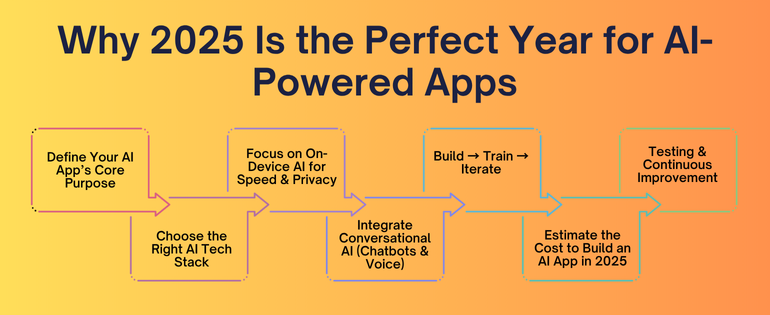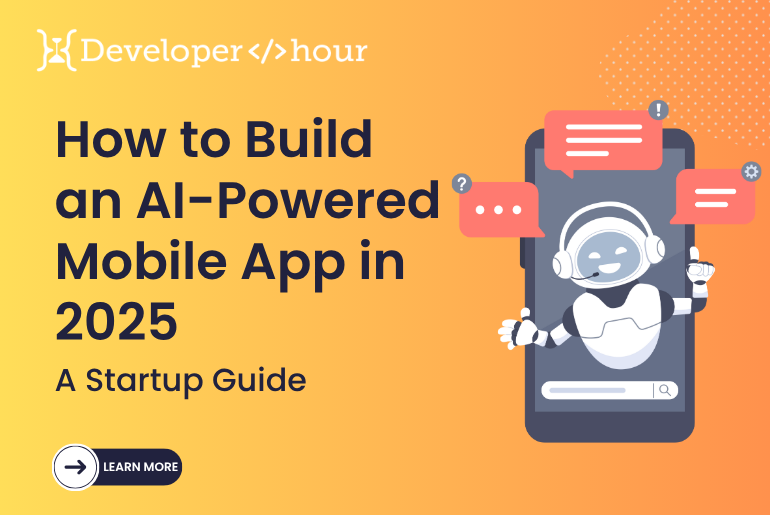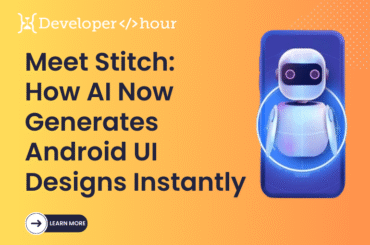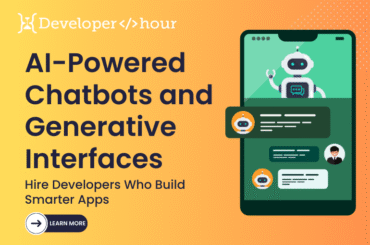Artificial Intelligence (AI) has evolved so much that it is not just a buzzword anymore — in 2025, it is the main driver of modern mobile apps. It doesn’t matter if it is a tailored shopping helper, predictive analytics for businesses, or an AI chatbot that facilitates customer experience; the fact that integrating the intelligence into apps has become a must-have to compete in the market rather than being a luxury is the common denominator.
If you are a startup, enterprise, or digital agency willing to create an AI-based mobile application, the present guide is a snapshot of the reality of AI app development in 2025, starting with the tech stack, practical implementation, costs, and hiring strategies.
Why 2025 Is the Perfect Year for AI-Powered Apps?

AI in-device has attained a high level of maturity in a short time span. Developers are now able to build apps that are not only responsive to the users’ needs, friendly with their privacy, and cost-effective, due to a sequence of technology breakthroughs comprising on-device AI, edge computing, and clever open-source models.
Some key 2025 AI trends influencing mobile app development:
- On-Device AI Apps: Reduced latency and enhanced privacy by processing data locally instead of on cloud servers.
- Generative AI: The main source of the next level of app experiences is the use of the generative AI technique, which covers text and image generation to intelligent design automation.
- Multimodal AI: The capacity to comprehend simultaneously text, images, voice, and gestures that are improving the accessibility and UX.
- AI Chatbot Development Services: Conversational AI that is human-like in interactions and therefore personalized, along with 24×7 engagement.
Consequently, startups get the advantage of a shorter period to enter the market, wiser decision-making, and a stronger customer base through the use of adaptive learning models.
How to Build an AI-Powered Mobile App in 2025: A Startup Guide
Step 1: Define Your AI App’s Core Purpose
The very first step for every winning app is the articulation of a clear problem statement.
Ask yourself:
- What is the user problem that the AI will solve in your app?
- In what way will your AI make money sense — by personalization, prediction, or automation?
- What data will your app have to collect to be able to learn and improve with time?
Example:
What is the user problem that the AI will solve in your app?
In what way will your AI make money sense — by personalization, prediction, or automation?
What data will your app have to collect to be able to learn and improve with time?
Step 2: Choose the Right AI Tech Stack
The structure of your AI mobile app depends on your technology stack.
Here’s a typical modern setup:
AI Frameworks & Libraries
- TensorFlow Lite / PyTorch Mobile are technologies that suit AI models that work on-device.
- OpenAI / Hugging Face APIs are resources that facilitate natural language processing and generative AI.
- Core ML (for iOS) and ML Kit (for Android) – performance enhancers of mobile SDKs that come from native.
Backend & Cloud
- AWS SageMaker, Google Vertex AI, Azure AI Hub – cover activities like training, deployment, and scaling.
- Firebase / Supabase – aimed at app hosting and authentication.
Frontend & UI
- The name of the toolkit may be Flutter, React Native, or Kotlin/Swift, which depends on the platform.
Startups make hybrid framework choices, such as Flutter for the delivery of faster MVP and lower costs, more often than other options.
Step 3: Focus on On-Device AI for Speed & Privacy
On-device AI is a very popular AI application development trend of 2025. Your app’s AI can be directly run on the device without sending every request to a server, resulting in:
- Zero waiting time (no network delay)
- Better privacy for data (user information stays on the device)
- Working without an internet connection (lower user frustration)
- Reduced expenses for cloud services
Example Use Case:
Rather than uploading for processing, a photo editing app that utilizes on-device AI for background removal or style transfer just does it by real-time processing.
Step 4: Integrate Conversational AI (Chatbots & Voice)
In 2025, nearly every successful app includes some form of AI chatbot or voice assistant.
AI chatbot development services allow you to embed conversational flows powered by LLMs (Large Language Models) such as GPT-4 Turbo or Gemini 1.5 Pro. These chatbots can:
- Recommending products or services based on the individual user
- Automatically responding to customer service questions
- To improve conversions, understanding user requirements is captured.
Reduced support costs and 24×7 engagement are the results for enterprises. Meanwhile, it aids the creation of intelligent, sticky experiences that fuel retention for startups.
Step 5: Build → Train → Iterate
AI apps are not “build-and-done” projects. Your dataset’s growth leads to its improvement over time.
Development Lifecycle Overview:
- Prototype the AI Model: One can rely on pre-trained open-source models or APIs for this.
- Use your own user data for fine-tuning the model.
- Deploy & Monitor: Besides evaluating model correctness, you are also able to oversee feedback loops.
- Iterate Regularly: To keep the model relevant, you should continually update it with new data.
One can efficiently handle this situation if they hire AI developers who are skilled in MLOps (Model Lifecycle Management). These experts not only assure the scalability of your models, but also their smooth updating and optimal performance.
Step 6: Estimate the Cost to Build an AI App in 2025
The AI app development cost is dependent on the complexity, integrations, and platform choice.
| App Type | AI Features | Approx. Cost Range (USD) |
| Basic AI Chatbot App | NLP Chatbot, Basic ML API | $25K – $40K |
| On-Device AI App | Custom Model, Image/Voice Processing | $50K – $80K |
| Advanced AI App (Multimodal, Predictive Analytics) | Custom Training, Enterprise Integration | $100K – $200K + |
Startups should begin with an MVP (Minimum Viable Product) — a smaller version that validates the AI’s core value before scaling.
Step 7: Testing & Continuous Improvement
Performance and accuracy are the main qualities that have to be proven by an AI app when it is continuously tested.
Key tests to be held:
- Data Quality Checks: An AI should not be allowed to train on biased or partial data.
- Model Accuracy Tests: Measure precision, recall, and F1 scores.
- User Experience Testing: Understand the users’ behavior when they use the AI features.
- Edge Case Validation: Unusual user behavior or data testing scenarios.
Automation tools and A/B testing frameworks can lead to these processes becoming more productive.
When to Hire AI Developers for Your Project?
The use of pre-built APIs and AI platforms can indeed speed an MVP creation. However, the need for skilled personnel will emerge to scale up the project eventually.
By means of AI developers, you get the chance of handing over the responsibility of professional staff who are capable of:
- Training AI models to suit local requirements (e.g., e-commerce, health, finance)
- work out AI functions locally on the device better
- Take Care of Data Pipelines and Deployment Security
- Help with AI mobile infrastructure integration
No matter whether you are a startup or a large company, by engaging an AI development firm, you get the best of innovation, scalability, and economic viability that Developer Per Hour is the closest partner to you in this mission.

Final Thoughts
In 2025, crafting an AI mobile app is not just about the use of fashionable technology but giving the users intelligent, adaptable, and useful experiences that become even smarter with every user session.
Start-ups, in turn, can turn to AI to bring about innovation and speed. Companies will use it in their favor to gain efficiency and scalability. Agencies, on the other hand, will implement it to provide their clients with data-driven solutions.
At Developer Per Hour, we equip businesses to ideate, build, and optimize AI-powered applications of any complexity, ranging from AI chatbot development services to complete on-device AI solutions.
Still, wondering how to make your AI dream a reality? Get in touch with Developer Per Hour right now to hire talented AI developers and see your brilliance turn into a smart reality.




